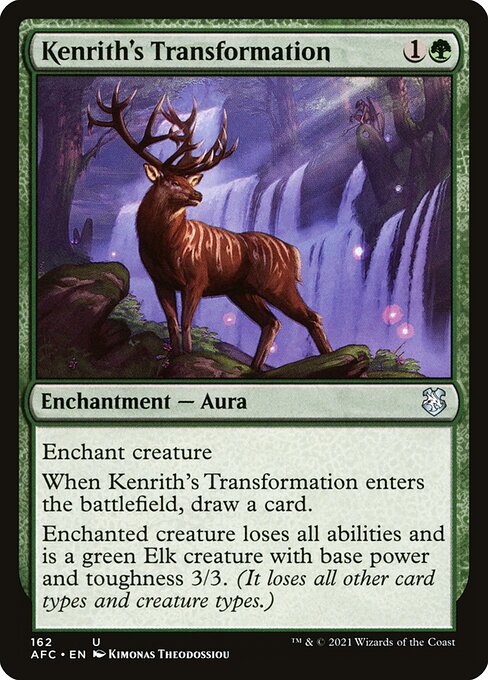
Image courtesy of Scryfall.com
The future of meta-aware card design
In Magic: The Gathering, the meta evolves as designers push toward cards that reward players for thinking ahead while inviting smart trades and creative misdirection. Meta-aware design is less about brute force and more about information, tempo, and the unsettled spaces between what a card promises and how it actually plays out on the battlefield 🧙♂️. Green has long excelled at card advantage and durable bodies, but in the last few years we’ve seen a shift toward enchantments and auras that alter the way a board looks and feels—often with a single, elegant line of text that creates ripple effects across formats. These are the cards that make players pause, reassess, and then rebuild their decks around new tempos and narratives 🔥.
Consider a green aura from Forgotten Realms Commander that costs {1}{G} to cast. It’s an Enchantment — Aura whose trigger is simple and deliciously disruptive: “When this Aura enters, draw a card.” Then it does something a little cheeky: “Enchant creature. Enchanted creature loses all abilities and is a green Elk creature with base power and toughness 3/3.” The amalgam of draw-a-card efficiency with a dramatic identity flip for the enchanted creature is exactly the kind of design that makes meta-shifts feel inevitable, not accidental 🧠💎. The art by Kimonas Theodossiou captures the whimsy and the bite of a spell that reshapes a board in one clean line, reminding us that magic often lies in the margins between what’s printed and what players discover over countless games 🎨⚔️.
Mechanics and design cautions
What makes this card a useful lens for meta-aware design is the tension it embodies. On one hand, it offers a cheap, immediate card draw at the moment you cast it, fueling engines and helping you find your bigger plays faster 🧙♂️. On the other hand, it imposes a hard trade-off: the enchanted creature loses all abilities and becomes a 3/3 green Elk. It’s a purposeful simplification that can neuter an otherwise potent attacker or a key activated ability. This duality invites designers to think about how much auras should bend a creature’s identity to unlock strategic choices—without breaking the balance of the format. In Commander, where the board often stretches to the limit and players lean on synergy, that kind of design becomes a powerful tool for shaping what is considered “value” in the meta 🔥.
From a gameplay perspective, this card highlights a broader trend in meta-aware design: value engines that scale with board presence and timing rather than raw stats alone. A draw-on-entry hook is a classic green theme, but coupling it with an immediate identity swap for the creature reframes how players evaluate risk and opportunity. You’re not just paying a mana cost to gain advantage; you’re committing a spell to a creature, trusting that the moment-to-moment advantage aligns with the long-term arc of your strategy. The result is a card that feels inevitable once you see it on the table—yet still invites creative plays and nuanced decisions ⚔️.
Practical implications for deckbuilding
Meta-aware designers will be watching how such a card influences deck archetypes in both casual and competitive spheres. Here’s what EDH/Commander players and designers might take away:
- Tempo vs. text disruption: Enchanting a key critter can disrupt opponent plans, but you trade away its abilities—be mindful of which targets you choose and how removal might tilt the ledger.
- Card draw as a tempo engine: The ETB draw helps smooth early turns, potentially accelerating you toward your high-impact plays or answers.
- Interaction with protection and shroud: Targeting constraints mean you must respect protection effects; some boards will demand clever sequencing or timing to maximize value.
- Green’s identity: This is a reminder that green’s complexity isn’t only about creatures; it’s about shaping how bodies function on the battlefield and how information parity can tilt decisions in your favor 🧙♂️.
- Design for multiple formats: A card that is legal in Commander and plays well in other eternal formats demonstrates how meta-aware balance can remain accessible while still offering depth for seasoned players 🧭.
As sets continue to bend toward flexibility and synergy, meta-aware design will increasingly reward players who read the room—spotting lines of play that look modest on the card but bloom into strong, nuanced outcomes with the right timing. The transformation from a creature’s identity to a 3/3 Elk isn’t just a flavor flourish; it’s a demonstration of how a single card can influence deck construction, removal strategy, and the tempo calculus players carry into every match 🧩💎.
And for fans who enjoy the tactile side of play, a well-lit desk setup can be as important as a well-tuned list. If you’re optimizing your battle space for long grindy sessions or quick, explosive games, a reliable non-slip mouse pad can keep your focus sharp while you track triggers and math. Speaking of which, a certain neon pad pairs nicely with those late-night upgrade sessions—shiny, steady, and ready for the next draw step. 🎲
Artistically and mechanically, this kind of design signals a trend toward cards that reward careful play over brute horsepower. It invites players to think about how a single aura can redefine a creature's role, alter the tempo of a board, and influence what “value” looks like in the moment. If you’re building the meta-aware deck of your dreams, keep an eye out for enchantments and auras that offer both a tempo nudge and a thoughtful risk-reward profile. The future of MTG design is in those careful, clever lines of text that tilt the battlefield with elegance and surprise 🧙♂️🔥💎.
Neon Gaming Mouse Pad Non-Slip 9.5x8in Anti-Fray
More from our network
- https://blog.digital-vault.xyz/blog/post/how-fans-influence-unconventional-tactics-in-mtg-design/
- https://crypto-acolytes.xyz/blog/post/best-loot-based-pc-games-for-gear-collectors/
- https://crypto-acolytes.xyz/blog/post/the-economics-of-sportsbooks-why-they-ban-the-best-bettors/
- https://crypto-acolytes.xyz/blog/post/crypto-day-trading-nail-the-best-risk-reward-ratios/
- https://crypto-acolytes.xyz/blog/post/grading-error-and-student-suicide-a-tragic-university-case/